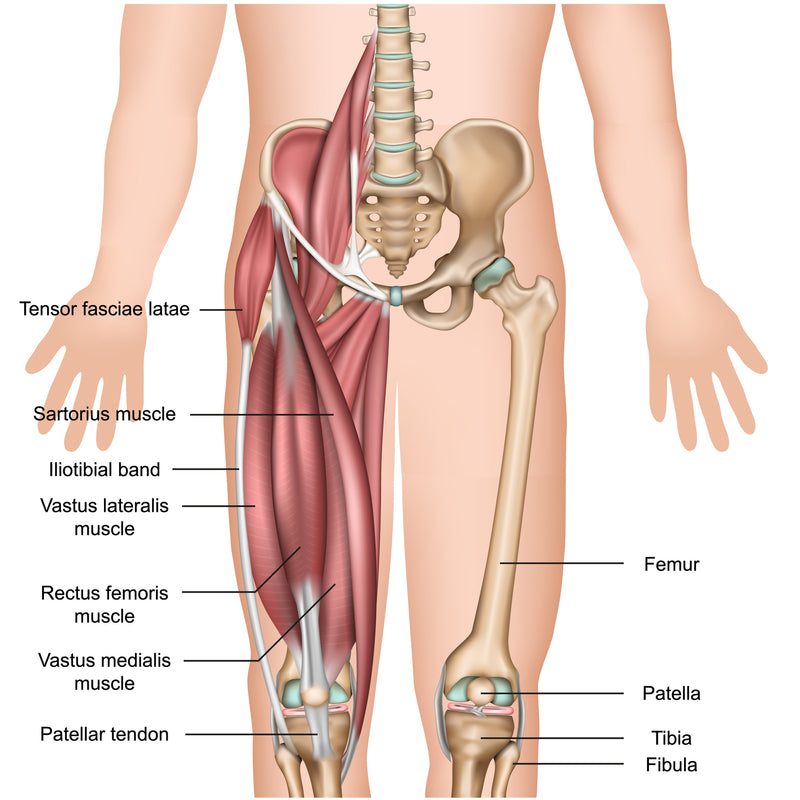Acupuncture for Tensor Fasciae Latae Pain
What is the Tensor Fasciae Latae (TFL)?
The Tensor Fasciae Latae (TFL) is a small muscle located in the hip and thigh region, playing a critical role in hip movement and stabilization. Arising from the anterior aspect of the iliac crest, it inserts into the iliotibial band, contributing to several key movements and functions of the leg. Trigger point acupuncture for Tensor Fascia Latae pain is one of the most effective tools.
- Location: The TFL resides on the outer side of the hip, extending towards the knee.
- Function: The primary role of the TFL is hip abduction, flexion, and internal rotation. It also helps stabilize the hip and knee while standing, walking, or running.
- Associated Pain: When overused or strained, the TFL can develop trigger points, leading to pain and discomfort, often referred to as TFL syndrome.
- Impact on Mobility: TFL pain can hinder mobility, particularly in activities requiring hip movement, such as running, climbing stairs, or even walking.

What does the TFL do?
The Tensor Fasciae Latae (TFL) muscle is an integral player in our body’s ongoing battle with gravity. It supports our body weight and aids in maintaining balance when we’re standing upright, effectively counteracting the downward pull of gravity. This is achieved via the muscle’s strategic location and its intricate ties with the iliotibial band (ITB), a thick band of fascia that runs down the outside of the leg.
- Counteracting Gravity: TFL muscle and the ITB work in unison to steady the femur on the tibia when standing, mitigating the gravitational force.
- Stabilizing Hip and Knee: The TFL muscle is instrumental in hip abduction, essential for maintaining balance, and aids in knee extension.
- Enabling Motion: The muscle facilitates internal rotation of the hip, a key movement in activities such as walking and running.
- Absorbing Impact: While running or jumping, the TFL helps absorb shock, reducing impact on the lower body.
What happens if you have trigger points n the TFL?
Trigger points in the Tensor Fasciae Latae (TFL) can lead to significant discomfort and are often associated with a condition known as TFL Syndrome. Here’s how these trigger points cause pain and can mimic common hip conditions:
- Pain Sensation: When the TFL muscle develops trigger points, it can cause sharp, stabbing, or aching pain sensations that radiate from the hip area.
- Mimicking Hip Conditions: The pain associated with TFL trigger points can often be misdiagnosed as other hip-related disorders due to its similarity in symptoms.
- Restricted Mobility: Just like other hip conditions, these trigger points can limit hip mobility, making movements like walking, running, or climbing stairs painful.
- Postural Changes: Trigger points in the TFL muscle may lead to changes in posture, mirroring the effects of certain chronic hip conditions.
- Disturbed Sleep: Like many other musculoskeletal disorders, TFL syndrome can also disrupt sleep due to the constant discomfort and pain.
Signs and Symptoms of TFL Tightness and Trigger Points
- Painful Hip Movements: Movements involving the hip, such as walking, running, or climbing stairs, may evoke pain. The pain might also intensify when the hip is flexed or when laying on the affected side.
- Pain in Lower Back: Patients might experience discomfort or pain in the lower back region due to an overcompensation of other muscles resulting from TFL tightness.
- Radiating Leg Pain: Pain from TFL trigger points can radiate down the outer thigh and sometimes extend to the knee, mimicking the symptoms of sciatica.
- Reduced Mobility: TFL tightness can lead to a decreased range of motion in the hip, affecting the ability to fully extend or rotate the hip.
- Increased Tension: There may be increased tension or a ‘tight’ sensation felt over the outer aspect of the thigh, from the hip down to the knee.
- Postural Changes: Individuals might display an altered gait or posture, possibly leaning to one side or limping due to the pain and tightness.
- Limited Stretching Ability: Difficulty or pain when attempting to stretch the hip or leg can be a symptom of TFL trigger points.
- Pain during Sitting or Standing: Discomfort may increase with prolonged sitting or standing, particularly in positions that put pressure on the affected side.
What is the referral pattern of TFL Trigger Points?

Trigger points in the Tensor Fasciae Latae can follow a specific referral pattern, as first established by the pioneering work of Dr. Janet Travell. Referral patterns are essential for diagnosing and treating trigger points as the pain often radiates to other areas, away from the actual source.
- Localized Sensation: Initially, the pain might be sharp and localized to the outer side of the thigh. This region corresponds directly to the location of the TFL muscle and the originating trigger points.
- Radiating Pain: As the condition progresses, the pain can start to radiate, extending downwards along the outside of the thigh and knee and sometimes reaching as far as the ankle. This pain can be intense and continuous, often misdiagnosed as sciatica due to the similar pattern of pain distribution.
- Referred Hip and Back Pain: The pain can also spread upwards, leading to discomfort in the hip and lower back region. This referred pain can make it challenging to identify the TFL as the source of the problem.
Understanding these referral patterns is crucial in the effective treatment of TFL trigger points. Misinterpreting the origin of the pain can lead to incorrect or ineffective therapy, underscoring the importance of accurate diagnosis.
How Do Tensor Fasciae Latae Trigger Points Form?
Trigger points in the Tensor Fasciae Latae muscle essentially form due to overuse or strain on the muscle. Here are a few common circumstances that might lead to the formation of these trigger points:
- Excessive Running or Walking: The TFL is heavily utilized during running, walking, and similar activities. Prolonged or excessive engagement in these activities can place substantial strain on the TFL, leading to the formation of trigger points.
- Inadequate Stretching: Failing to adequately stretch before rigorous physical activity can result in muscle tightness and the subsequent development of trigger points.
- Poor Posture: Maintaining poor posture, especially when sitting or standing for extended durations, can put undue stress on the TFL, eventually causing trigger points to form.
- Physical Trauma: Any direct injury or trauma to the muscle can also lead to the development of trigger points.
- Imbalanced Musculature: Imbalances in the body’s musculature, particularly in the hips and lower body, can overburden the TFL, fostering the formation of trigger points.
How Can Trigger Point Acupuncture Release TFL Trigger Points?
Trigger point acupuncture serves as a potent tool for releasing TFL trigger points and alleviating associated pain. Here’s how it works:
- Targeting Specific Points: Acupuncture involves inserting needles into the trigger points of the TFL, initiating the release of these tense areas.
- Stimulating Blood Flow: The needles stimulate blood flow to the affected region, promoting natural healing and recovery.
- Reducing Muscle Tension: By targeting the knots in the muscle, acupuncture can reduce tension, enhance flexibility, and improve the range of motion.
- Alleviating Pain: Studies suggest that acupuncture can help reduce pain by influencing the body’s pain pathways and releasing endorphins, the body’s natural painkillers.
- Promoting Relaxation: The treatment can also encourage overall relaxation, further aiding in the release of muscle tightness.
In conclusion, Tensor Fasciae Latae pain, mainly caused by trigger points, can significantly impact one’s daily life, affecting mobility, posture, and overall wellbeing. Thankfully, solutions like trigger point acupuncture provide a promising avenue for relief. Expertly targeting these pain points, acupuncture stimulates blood flow, reduces muscle tension, alleviates pain, and promotes relaxation. If you’re struggling with TFL pain and considering acupuncture as a treatment option, reach out to expert Dr. Hanson at 813-534-0311. Take the first step towards a pain-free life today.


